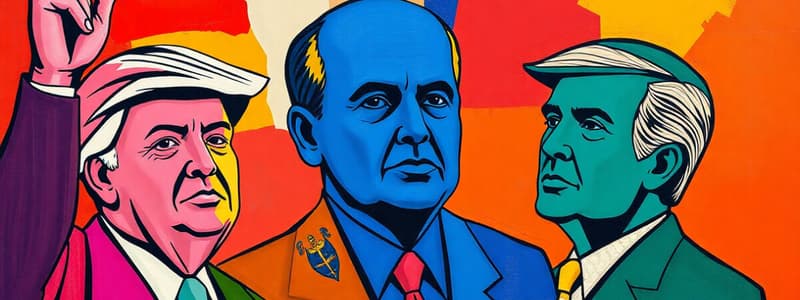Podcast
Questions and Answers
Which of the following best describes the social movement theory perspective on political parties?
Which of the following best describes the social movement theory perspective on political parties?
- Parties are inherently resistant to social change.
- Parties are formed in response to economic indicators exclusively.
- Parties are primarily driven by individual politicians' ambitions.
- Parties are offshoots of social movements. (correct)
Which of the following is the MOST likely indicator of party dealignment within a political system?
Which of the following is the MOST likely indicator of party dealignment within a political system?
- A rise in split-ticket voting and independent voter registration. (correct)
- Stronger party identification among young voters.
- Greater financial contributions to established party organizations.
- Increased voter turnout in primary elections.
A political party seeking renewal in the face of declining membership would MOST likely focus on:
A political party seeking renewal in the face of declining membership would MOST likely focus on:
- Restricting access to party decision-making processes to long-time members.
- Ignoring emerging social issues to maintain ideological purity.
- Leveraging social media to engage with voters and modernizing its platform. (correct)
- Maintaining traditional organizational structures and methods.
How might increased social mobility contribute to party decline?
How might increased social mobility contribute to party decline?
Which of the following represents an adaptation strategy a political party might use to address the rise of populism?
Which of the following represents an adaptation strategy a political party might use to address the rise of populism?
Which of the following best describes the primary function of political parties in a democracy?
Which of the following best describes the primary function of political parties in a democracy?
A political party is formulating its platform. Which activity would be the MOST essential for them to undertake?
A political party is formulating its platform. Which activity would be the MOST essential for them to undertake?
If a country's political landscape is dominated by two major parties that regularly alternate in power, this is referred to as what kind of system?
If a country's political landscape is dominated by two major parties that regularly alternate in power, this is referred to as what kind of system?
What is the MOST likely outcome in a multi-party system where no single party can secure a majority?
What is the MOST likely outcome in a multi-party system where no single party can secure a majority?
Which factor is MOST influential in shaping an individual's long-term attachment to a political party?
Which factor is MOST influential in shaping an individual's long-term attachment to a political party?
A voter consistently supports the same political party across different elections. How does this behavior MOST directly influence the voter's decision-making process?
A voter consistently supports the same political party across different elections. How does this behavior MOST directly influence the voter's decision-making process?
A local party organization is deciding how to MOST effectively influence an upcoming election. Which approach should they prioritize?
A local party organization is deciding how to MOST effectively influence an upcoming election. Which approach should they prioritize?
What is the PRIMARY goal of catch-all political parties?
What is the PRIMARY goal of catch-all political parties?
An environmental advocacy group forms a political party to specifically address climate change and conservation. What type of party is this?
An environmental advocacy group forms a political party to specifically address climate change and conservation. What type of party is this?
What is a central debate surrounding party finance regulations?
What is a central debate surrounding party finance regulations?
How do political parties contribute to stability and coherence in government?
How do political parties contribute to stability and coherence in government?
A political party's membership declines significantly. What challenge does this MOST directly pose for the party?
A political party's membership declines significantly. What challenge does this MOST directly pose for the party?
What is a consequence of weakening party identification among voters?
What is a consequence of weakening party identification among voters?
In electoral theories of political parties, what MAIN strategy do parties employ to attract the MOST voters?
In electoral theories of political parties, what MAIN strategy do parties employ to attract the MOST voters?
Which aspect of political parties is examined in organizational theories?
Which aspect of political parties is examined in organizational theories?
Flashcards
Social Movement Theories
Social Movement Theories
Parties originate from and work with larger societal forces.
Party Decline
Party Decline
Weakening of traditional party structures and functions.
Dealignment
Dealignment
Voters detach from parties, leading to more independent voting.
Renewal Strategies
Renewal Strategies
Signup and view all the flashcards
Future of Parties
Future of Parties
Signup and view all the flashcards
Political Parties
Political Parties
Signup and view all the flashcards
Nominating Candidates
Nominating Candidates
Signup and view all the flashcards
Campaigning
Campaigning
Signup and view all the flashcards
Structuring the Vote Choice
Structuring the Vote Choice
Signup and view all the flashcards
Policy Formulation
Policy Formulation
Signup and view all the flashcards
Educating the Public
Educating the Public
Signup and view all the flashcards
Coordinating Government
Coordinating Government
Signup and view all the flashcards
Party System
Party System
Signup and view all the flashcards
Single-Party Systems
Single-Party Systems
Signup and view all the flashcards
Two-Party Systems
Two-Party Systems
Signup and view all the flashcards
Multi-Party Systems
Multi-Party Systems
Signup and view all the flashcards
Party Identification
Party Identification
Signup and view all the flashcards
Catch-All Parties
Catch-All Parties
Signup and view all the flashcards
Ideological Parties
Ideological Parties
Signup and view all the flashcards
Single-Issue Parties
Single-Issue Parties
Signup and view all the flashcards
Study Notes
- Political parties seek to influence government policy by nominating candidates and contesting elections.
- They structure political choices for voters in democratic systems.
- Parties consolidate various interests and opinions into coherent political programs.
- Political parties serve as a crucial link between citizens and the government.
Functions of Political Parties
- Nominating Candidates: Parties select and endorse candidates for public office.
- This provides a pool of potential leaders.
- Campaigning: Parties organize and manage election campaigns.
- They mobilize resources and voters to support their candidates.
- Structuring the Vote Choice: Parties simplify voter choices by offering platforms and candidates aligned with specific ideologies or interests.
- Policy Formulation: Parties create policy platforms reflecting their values and goals.
- Educating the Public: Parties inform the public about issues, shape opinions, and encourage engagement.
- Coordinating Government: Parties organize and coordinate government action, especially in parliamentary systems.
- The party in power often controls the executive branch.
Party Systems
- A party system is the pattern of competition between political parties in a country.
- Party systems are categorized by the number and strength of parties.
- Single-party systems: Dominated by one party that controls the government and restricts competition.
- Two-party systems: Dominated by two major parties that alternate in power.
- Multi-party systems: Characterized by multiple parties, often leading to coalition governments.
- No single party is likely to win a majority.
Party Identification and Voters
- Party identification is an individual's attachment to a political party.
- It is a stable attitude influencing voting behavior.
- Voters use party identification as a heuristic to make voting decisions.
- Party identification is influenced by family, social groups, and personal experiences.
- Strong party identification increases the likelihood of voting for the party's candidates and participating in political activities.
Party Organization
- Political parties are organized at local to national levels.
- Local party organizations mobilize grassroots support and conduct voter outreach.
- State party organizations coordinate activities and support candidates at the state level.
- National party organizations set the party's direction, raise money, and coordinate national campaigns.
- Party organizations include professional staff and volunteers.
Types of Political Parties
- Catch-all parties appeal to a broad range of voters, often moderating their stances.
- Ideological parties promote specific beliefs through political action.
- Single-issue parties focus on one cause like environmental protection or gun control.
- Niche parties appeal to specific electorate segments, such as ethnic or religious groups.
Party Finance
- Political parties need funding to operate and campaign.
- Parties raise money from individual donors, corporations, and labor unions.
- Government regulations on party finance vary across countries.
- Some countries offer public funding, while others rely on private funding.
- Debates on party finance often concern fairness, transparency, and corruption.
The Role of Parties in Democracies
- Political parties are vital in democratic systems.
- They allow citizen participation, hold officials accountable, and shape policy.
- Parties promote stability by organizing the political process and offering clear choices.
- They represent diverse interests, ensuring all voices are heard.
Political Party Challenges
- Declining Membership: Parties in established democracies face declining membership.
- This reduces grassroots support and volunteer base.
- Decreasing Party Identification: Weakened party identification leads to more volatile voting.
- Increased Political Fragmentation: New parties fragment the political landscape, making it harder to form majorities.
- Financial Constraints: Parties struggle to raise enough money to compete, especially against wealthy donors.
- Impact of Digital Media: Digital media disrupts traditional communications, challenging parties to adapt.
Theories of Political Parties
- Electoral theories emphasize rational choice models where parties adjust platforms to maximize voter appeal.
- Organizational theories examine the internal structure and processes of parties.
- Party system theories classify systems based on the number, size, and interactions of parties.
- They are classified as single-party, two-party, or multi-party.
- Social movement theories see parties as products of social movements, focusing on how parties emerge from and interact with broader social forces.
Party Decline and Dealignment
- Party decline is the weakening of party structures, including declining membership, party identification, and voter turnout.
- Dealignment is when voters become less attached to parties, leading to independent voting.
- Factors contributing to decline and dealignment: increased social mobility, the rise of mass media, a decline in social capital, and growing distrust of political institutions.
Party Renewal and Adaptation
- Despite challenges, parties can adapt and renew themselves.
- Renewal strategies include modernizing organizations, adopting new technologies, social media engagement, and inclusive decision-making.
- Parties can renew by forming coalitions, recruiting leaders, and developing innovative policy solutions.
The Future of Parties
- The future of parties is uncertain, but they will likely remain central to democratic politics.
- Parties that adapt, engage voters in new ways, and offer solutions will succeed.
- The rise of populism, social media, and globalized issues will shape party functions.
Studying That Suits You
Use AI to generate personalized quizzes and flashcards to suit your learning preferences.
Description
Political parties nominate candidates and mobilize voters. They play a crucial role in democratic systems by structuring political choices. Parties aggregate diverse interests into coherent political programs.




